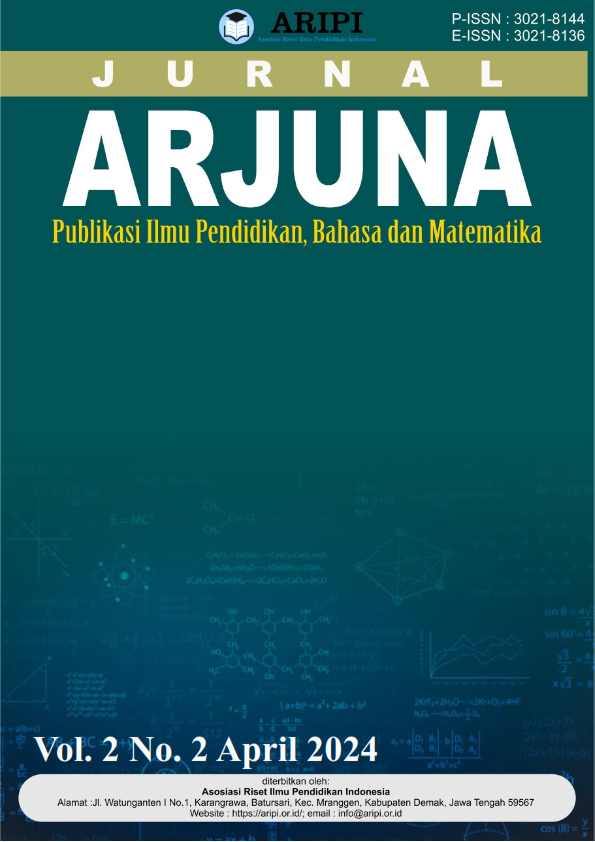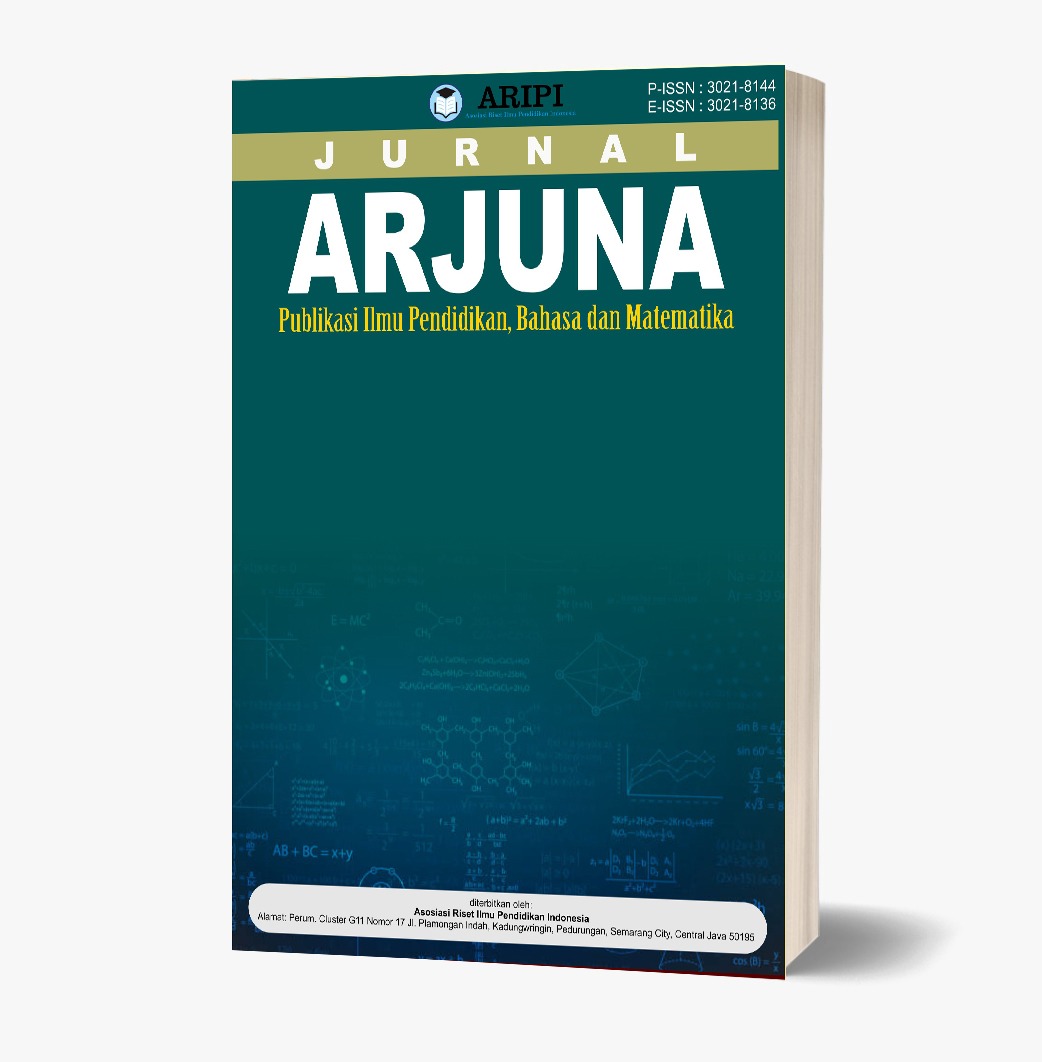Komunikasi Guru dan Siswa Kelas XII MPLB dalam Pembelajaran Pengelolaan Sumber Daya Manusia di SMKN 1 Surakarta
DOI:
https://doi.org/10.61132/arjuna.v2i2.693Keywords:
Process, Pattern, Strategy, Communication, LearningAbstract
This research aims to determine: (1) the communication process of teachers and students; (2) the communication pattern of teachers and students; and (3) the teacher's strategy to communicate with class XII MPLB students in learning human resource management at SMK N 1 Surakarta. This research is mixed with the type of sequential explanatory designs using descriptive quantitative and qualitative phenomenological research approaches. Respondents are all students of class XII MPLB and informants of teachers and students of class XII MPLB SMK N 1 Surakarta. The sampling technique used was quota sampling for quantitative data and purposive sampling for qualitative data. Data collection was done by questionnaire, interview, observation, and document study. The data validity test technique was carried out with content validation for quantitative data and reliability testing with source triangulation and technical triangulation, transferability testing, dependability testing, and confirmability testing. Quantitative data analysis used descriptive and qualitative data that was analyzed with an interactive model. The results showed that: (1) The communication process of teachers and students of class XII MPLB in learning human resource management at SMK N 1 Surakarta is still not optimal, with the majority using mixed language, fierce expressions, and voice intonations that are tense and frightening. (2) Communication patterns that occur in learning are one-way, two-way, and multi-directional. However, as much as 44.8% of the communication that occurs is one-way, which means that the tendency of communication that occurs is one-way because teachers tend to only lecture and tell their personal experiences, and students' perceptions if they ask questions or have opinions are not on their own initiative. As many as 51.4% of students' courage to ask questions is not optimal because students are afraid of teachers who look fierce and feel embarrassed with their friends. As many as 52.4% of students' courage in conveying ideas is not optimal because they are afraid of their fierce teachers and are not confident. As many as 54.3% of students feel that teachers value students' opinions, but there are also those who feel otherwise. (3) The communication strategy carried out by the teacher is to use a friendly approach to create a good relationship between teachers and students. In addition, teachers also show cheerfulness in learning by using humor to create a pleasant learning atmosphere and help students feel motivated to learn. Thus, these strategies help create a positive learning environment and support students' active participation.
Downloads
References
Cangara, H. (2017). Perencanaan dan strategi komunikasi. Raja Grafindo Perkasa.
Dafit. (2023). Komunikasi antara guru dan siswa: strategi untuk memfasilitasi pembelajaran. Kompasiana. https://www.kompasiana.com/fitriawardani8538/64c4fab64addee4f277a4ef3/komunikasi-antara-guru-dan-siswa-strategi-untuk-memfasilitasi-pembelajaran
Giantika, G. G. (2020). Strategi komunikasi guru dalam upaya meningkatkan proses pembelajaran siswa SDN Tebet Barat 01 Jakarta Selatan di masa pandemi covid -19. Jurnal Komunikasi, 11, 143–150. https://doi.org/https://10.31294/jkom
Lasompo, N., & Nadjamuddin, A. (2020). Pengaruh komunikasi guru terhadap motivasi belajar siswa. educator : Directory of Elementary Education Journal, 1, 24–40.
Latuconsina, A. (2019). Pola komunikasi guru di ruang publik sekolah. Al-Iltizam: Jurnal Pendidikan Agama Islam, 4(2), 85. https://doi.org/10.33477/alt.v4i2.1008
Mahadi, U. (2021). Komunikasi pendidikan (urgensi komunikasi efektif dalam proses pembelajaran). JOPPAS: Journal of Public Policy and Administration Silampari, 2(2), 80–90. https://doi.org/10.31539/joppa.v2i2.2385
Nur, I. E. (2019). Peran komunikasi dalam interaksi guru dan siswa. Jurnal Al-Ta’dib, 8(2), 150–167.
Permana, H., & Suhartini, T. (2020). Pola komunikasi guru dan murid menggunakan metode pembelajaran kelas daring di Kota Bandung. Jurnal Ilmu Komunikasi, 9, 170–182.
Sari, Y. P. (2019). Pola komunikasi antarbudaya di Kelurahan Kampung Jawa Kecamatan Curup Tengah Kabupaten Rejang Lebong. Jurnal Dakwah Dan Komunikasi, 3(2), 151. https://doi.org/https://doi.org/10.29240/jdk.v3i2.64
Siska Anggraini, E. (2021). Pola komunikasi guru dalam pembelajaran anak usia dini melalui bermain. Jurnal Bunga Rampai Usia Emas, 7(1), 27–37.
Sugiyono. (2014). Metode penelitian pendidikan pendekatan kuantitatif, kualitatif, dan R&D. Alfabeta.
Suprapti, D. (2018). Pengaruh pola komunikasi antara guru, orang tua wali, dan siswa dalam proses belajar anak. Sendika Fkip Uad, II(1), 177.
Yohanah, I. D., & Setyawan, A. (2017). Pola komunikasi antara guru dengan anak didik pada sekolah dasar model inklusi. Jurnal Komunikasi, VIII(September), 132–135.
Yusriah. (2019). Strategi komunikasi dalam pembelajaran. JPPI (Jurnal Pendidikan Islam Pendekatan Interdisipliner, 3(1), 16–27.
Downloads
Published
How to Cite
Issue
Section
License
Copyright (c) 2024 Jurnal Arjuna : Publikasi Ilmu Pendidikan, Bahasa dan Matematika

This work is licensed under a Creative Commons Attribution-ShareAlike 4.0 International License.







